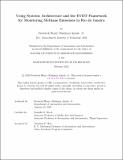Using Systems Architecture and the EVDT Framework for Monitoring Methane Emissions in Rio de Janeiro
Author(s)
Ajisafe Jr., Frederick Henry Oladimeji
DownloadThesis PDF (16.40Mb)
Advisor
Wood, Danielle R.
Terms of use
Metadata
Show full item recordAbstract
Methane is a powerful greenhouse gas that has important implications for climate change. Over the past decade, satellites have rapidly improved their ability to detect this gas from above the atmosphere. This Thesis uses two Systems Engineering frameworks, Systems Architecture and EVDT, to examine a case study of methane monitoring in Rio de Janeiro, Brazil. Data from one of these novel satellite systems, GHGSat, is taken over the Seropédica landfill near the city, and compared to Rio’s own IPCC- and GPC-derived greenhouse gas inventory. This is followed by a participant observation in the summer of 2024 involving interviews, discussions, and site visits. A near-doubling of methane was observed over Seropédica, raising questions about the cause of this increase. The direct engagement with Stakeholders provided by this study contributes to a literature gap in satellite monitoring of urban landfills in southeastern Brazil.
Date issued
2025-02Department
Massachusetts Institute of Technology. Department of Aeronautics and AstronauticsPublisher
Massachusetts Institute of Technology